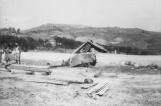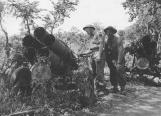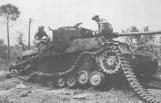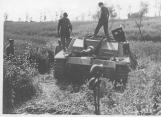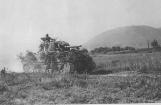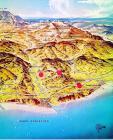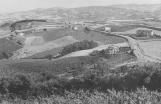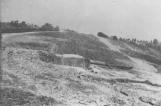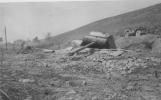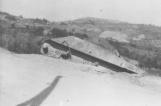53
Anti tank obstacle on the Hitler Line in the Liri Valley, Italy.1944
Somewhere in the Liri Valley, Italy

55
In May 1944, (a month before the D-Day landings in Normandy) the Regiment was committed to battle for the first time, along with the rest of the 5th CAD and 1 Canadian Corps. They were to clear a path to Rome. First the 1st Canadian Infantry Division (1st CID) fought through the "Hitler Line" in the Liri Valley south of Rome. Then, the 5th CAD fought through the improvised German defences and reserve formations at the battle of the Melfa River crossing. The Regiment led the Division and was under the command of Lt. Col. F. A. Vokes, a graduate of the Royal Military College, a former Lord Strathcona officer and an aggressive, even impatient man. Major David Kinloch's 'B' Squadron encountered and knocked out the first Panther tanks in Italy, (Lt. Nigel Taylor's tank got the first), the German commander's special reserve. The Strathcona's were to cross the Melfa, but lost 17 tanks in hard fighting and stalled. Vokes sent 'C' Squadron to their aid. They crossed and secured the bridgehead at the cost of two troops. In the close and difficult country the Honey recce tanks performed well. Breaching the German defence forced them to abandoned Rome.This was the start of the Regiment's trek north up the west coast and then cross over to the east coast to go further north for a total of 500 miles, not counting tortuous and winding roads or battle distances.
On 31 August 1944, the Regiment was heavily engaged in breaking the "Gothic Line." Major-General Bert Hoffmeister, a Seaforth Highlander of Canada militiaman from Vancouver, commanded the 5th CAD. He was a bold, aggressive and charismatic commander who did not wait to give the Germans time to react. He decided to attack the Gothic Line as soon as possible and he gave the lead to the Dragoons. Lt. Col. Vokes decided not to wait for infantry support and attacked without it. During the twelve hours of continuous battle the Dragoons lost 32 of the 50 tanks that entered the battle, and over 50 officers and men killed or wounded, including Vokes, who was mortally wounded in the advance. The Regiment took and held its objectives thereby cracking the Gothic Line, forcing the Germans to withdraw as other units and formations broadened the crack.
The battered but proud regiment was taken over that evening by former commander, Lt. Col. Harry Angle; sent by Maj-Gen. Hoffmeister from his position as chief of staff at 5th CAD headquarters. Angle stayed on as Commanding Officer (CO) for the rest of the war. The losses were serious; indeed, veterans of the battle called the route of advance "Death Valley." The Germans had cleared a large area of brush and other cover to provide an unobstructed field of fire for their heavily fortified, anti-tank guns. The battle brought recognition to the 5th CAD from the 8th Army's commander, General Oliver Leese. He told General Montgomery, who was then in Normandy, "The troops fought well, especially the 5th CAD. This Division led by Bert Hoffmeister, has the terrific dash of the 7th Armoured (Desert Rats Division) in the old days. They have done extremely well."
Over the years the historians have reviewed the battle to the Regiment's favour. Some historians, such as Dr. Wm McAndrews, think that Lt. Col. Vokes should have received the Victoria Cross for having the moral courage to violate tactical doctrine and attack without close infantry support. One of the severest critics of the Canadian Army's training and operations, John English, wrote that the operation on the Gothic Line "may have been the finest by any Canadian formation in the Second World War."
Next, the Dragoons endured the heavy shelling and mortaring in the fighting around Coriano Ridge in September 1944. Later in the fall, they advanced through Rimina and Ravenna and over to the Lamone River, and into the flat, wet Romagna country of northern Italy, ending the fighting near the Bay of Commachio. As Lt. Col. Angle noted in his diary on January 6, 1945: "That's that. We did it again. We have put flank of Eighth Army on the Adriatic and along southern end of Lake Commachio. The General is delighted - and so should be - these men are superb. Thank God, casualties light. I am going to sleep for a week."
66
This is one of several BCD tanks knocked out during the BCDs breaching of the Gothic Line.1944
Near Tavullia, Italy
